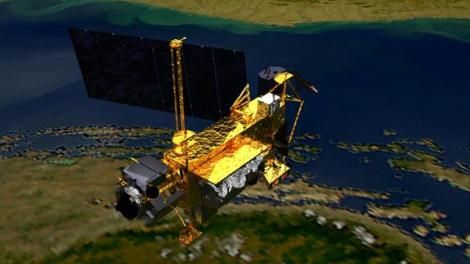
© Unknown
A 6-ton NASA satellite on a collision course with Earth is set to fly over Washington state Friday evening -- if it doesn't fall out of orbit sooner.
The Upper Atmosphere Research Satellite, or UARS, is expected to pass over Washington state at 9:20 p.m. PT -- on a path that will take it on a northeasterly course from the mouth of the Columbia River and south of Olympia to the Canadian border.
When it passes over, the satellite may be low enough that the atmosphere is heating it, making it brighter in the sky than it would normally appear.
NASA cautioned there was now a slim chance any surviving debris would land in the United States. Earlier this week, NASA said North America would be in the clear.
"It is still too early to predict the time and location of re-entry with any certainty," NASA said in a statement.
The Aerospace Corp., which tracks space debris, estimates the strike will happen sometime between about 6 p.m. and 4 a.m. EDT, which would make a huge difference in where the debris might wind up. Those late-night, early morning passes show the satellite flying over parts of the United States.
Any surviving wreckage is expected to be limited to a 500-mile swath.
The UARS satellite will be the biggest NASA spacecraft to crash back to Earth, uncontrolled, since the post-Apollo 75-ton Skylab space station and the more than 10-ton Pegasus 2 satellite, both in 1979.
Russia's 135-ton Mir space station slammed through the atmosphere in 2001, but it was a controlled dive into the Pacific.
Some 26 pieces of the UARS satellite -- representing 1,200 pounds of heavy metal -- are expected to rain down somewhere.
The biggest surviving chunk should be no more than 300 pounds.Earthlings can take comfort in the fact that no one has ever been hurt by falling space junk -- to anyone's knowledge -- and there has been no serious property damage. NASA put the chances that somebody somewhere on Earth would get hurt at 1-in-3,200. But any one person's odds of being struck were estimated at 1-in-22 trillion, given there are 7 billion people on the planet.
"Keep in mind that we have bits of debris re-entering the atmosphere every single day," NASA orbital debris scientist Mark Matney said in brief remarks broadcast on NASA TV.
In any case, finders definitely aren't keepers.
Any surviving wreckage belongs to NASA, and it is against the law to keep or sell even the smallest piece. There are no toxic chemicals on board, but sharp edges could be dangerous, so the space agency is warning the public to keep hands off and call police.
The $740 million UARS was launched in 1991 from space shuttle Discovery to study the atmosphere and the ozone layer. At the time, the rules weren't as firm for safe satellite disposal; now a spacecraft must be built to burn up upon re-entry or have a motor to propel it into a much higher, long-term orbit.
NASA shut UARS down in 2005 after lowering its orbit to hurry its end. A potential satellite-retrieval mission was ruled out following the 2003 shuttle Columbia disaster, and NASA did not want the satellite hanging around orbit posing a debris hazard.
Space junk is a growing problem in low-Earth orbit. More than 20,000 pieces of debris, at least 4 inches in diameter, are being tracked on a daily basis. These objects pose a serious threat to the International Space Station.
"...no one has ever been hurt by falling space junk..." Huh?
If that means that no one has ever been STRUCK by falling space junk, then that is probably a correct statement.
[Link]
"On 24 January 1978, COSMOS 954, a Soviet nuclear-powered surveillance satellite, crashed in the Northwest Territories. The crash scattered a large amount of radioactivity over a 124,000 square kilometre area in Canada's north, stretching southward from Great Slave Lake into northern Alberta and Saskatchewan."
There's plutonium aboard the UARS. According to what I have read, it is likely to survive re-entry.
My point is that one doesn't have to be STRUCK by space debris to be HURT by it.